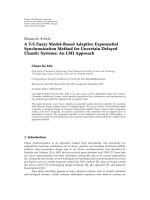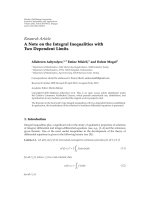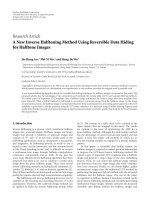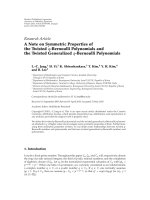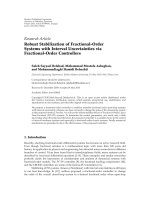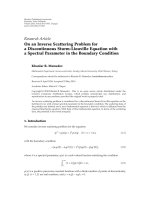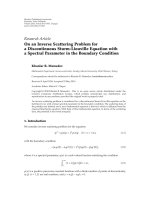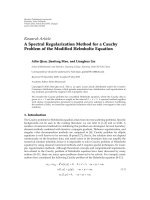Báo cáo sinh học: " Research Article Aλ3 λ1 , λ2 , Ω -Weighted Inequalities with Lipschitz r and BMO Norms" doc
Bạn đang xem bản rút gọn của tài liệu. Xem và tải ngay bản đầy đủ của tài liệu tại đây (522.56 KB, 14 trang )
Hindawi Publishing Corporation
Journal of Inequalities and Applications
Volume 2010, Article ID 589040, 14 pages
doi:10.1155/2010/589040
Research Article
A
λ
3
r
λ
1
,λ
2
, Ω-Weighted Inequalities with Lipschitz
and BMO Norms
Yuxia Tong,
1
Juan Li,
2
and Jiantao Gu
1
1
College of Science, Hebei Polytechnic University, Tangshan 063009, China
2
Department of Mathematics, Ningbo University, Ningbo 315211, China
Correspondence should be addressed to Yuxia Tong,
Received 29 December 2009; Revised 25 March 2010; Accepted 31 March 2010
Academic Editor: Shusen Ding
Copyright q 2010 Yuxia Tong et al. This is an open access article distributed under the Creative
Commons Attribution License, which permits unrestricted use, distribution, and reproduction in
any medium, provided the original work is properly cited.
We first define a new kind of A
λ
3
r
λ
1
,λ
2
, Ω two-weight, then obtain some two-weight integral
inequalities with Lipschitz norm and BMO norm for Green’s operator applied to differential forms.
1. Introduction
Green’s operator G is often applied to study the solutions of various differential equations
and to define Poisson’s equation for differential forms. Green’s operator has been playing
an important role in the study of PDEs. In many situations, the process to study solutions
of PDEs involves estimating the various norms of the operators. Hence, we are motivated to
establish some Lipschitz norm inequalities and BMO norm inequalities for Green’s operator
in this paper.
In the meanwhile, there have been generally studied about A
r
Ω-weighted 1, 2
and A
λ
r
Ω-weighted 3, 4 different inequalities and their properties. Results for more
applications of the weight are given in 5, 6. The purpose of this paper is to derive the new
weighted inequalities with the Lipschitz norm and BMO norm for Green’s operator applied
to differential forms. We will introduce A
λ
3
r
λ
1
,λ
2
, Ω-weight, which can be considered as a
further extension of the A
λ
r
Ω-weight.
We keep using the traditional notation.
Let Ω be a connected open subset of R
n
,lete
1
,e
2
, ,e
n
be the standard unit basis of
R
n
,andlet
l
l
R
n
be the linear space of l-covectors, spanned by the exterior products
e
I
e
i
1
∧ e
i
2
∧···∧e
i
l
, corresponding to all ordered l-tuples I i
1
,i
2
, ,i
l
,1≤ i
1
<i
2
< ···<
i
l
≤ n, l 0, 1, ,n.WeletR R
1
. The Grassman algebra
⊕
l
is a graded algebra with
respect to the exterior products. For α
α
I
e
I
∈
and β
β
I
e
I
∈
, the inner product
2 Journal of Inequalities and Applications
in
is given by α, β
α
I
β
I
with summation over all l-tuples I i
1
,i
2
, ,i
l
and all
integers l 0, 1, ,n.
We define the Hodge star operator :
→
by the rule 1 e
1
∧ e
2
∧···∧e
n
and
α ∧ β β ∧ α α, β1 for all α, β ∈
. The norm of α ∈
is given by the formula
|α|
2
α, α α ∧ α ∈
0
R. The Hodge star is an isometric isomorphism on
with
:
l
→
n−l
and −1
ln−l
:
l
→
l
.
Balls are denoted by B and ρB is the ball with the same center as B and with
diamρBρ diamB. We do not distinguish balls from cubes throughout this paper.
The n-dimensional Lebesgue measure of a set E ⊆ R
n
is denoted by |E|. We call wx
a weight if w ∈ L
1
loc
R
n
and w>0 a.e. For 0 <p<∞ and a weight wx, we denote the
weighted L
p
-norm of a measurable function f over E by
f
p,E,w
α
E
f
x
p
w
α
dx
1/p
, 1.1
where α is a real number.
Differential forms are important generalizations of real functions and distributions.
Specially, a differential l-form ω on Ω is a de Rham current 7, Chapter III on Ω with values
in
l
R
n
; note that a 0-form is the usual function in R
n
.Adifferential l-form ω on Ω is a
Schwartz distribution on ω with values in
l
R
n
.WeuseD
Ω,
l
to denote the space of all
differential l-forms ωx
I
ω
I
xdx
I
ω
i
1
i
2
···i
l
xdx
i
1
∧dx
i
2
∧···∧dx
i
l
. We write L
p
Ω,
l
for the l-forms with ω
I
∈ L
p
Ω, R for all ordered l-tuples I.ThusL
p
Ω,
l
is a Banach space
with norm
ω
p,Ω
Ω
|
ω
x
|
p
dx
1/p
Ω
|
ω
I
x
|
2
p/2
dx
1/p
. 1.2
For ω ∈ D
Ω,
l
the vector-valued differential form
∇ω
∂ω
∂x
1
, ,
∂ω
∂x
n
1.3
consists of differential forms
∂ω
∂x
i
∈ D
Ω,
l
, 1.4
where the partial differentiations are applied to the coefficients of ω.
As usual, W
1,p
Ω,
l
is used to denote the Sobolev space of l-forms, which equals
L
p
Ω,
l
∩ L
p
1
Ω,
l
with norm
ω
W
1,p
Ω,
l
ω
W
1,p
Ω,
l
diam
Ω
−1
ω
p,Ω
∇ω
p,Ω
. 1.5
Journal of Inequalities and Applications 3
The notations W
1,p
loc
Ω, R and W
1,p
loc
Ω,
l
are self-explanatory. For 0 <p<∞ and a weight
wx, the weighted norm of ω ∈ W
1,p
Ω,
l
over Ω is denoted by
ω
W
1,p
Ω,
l
,w
α
ω
W
1,p
Ω,
l
,w
α
diam
Ω
−1
ω
p,Ω,w
α
∇ω
p,Ω,w
α
, 1.6
where α is a real number.
We denote the exterior derivative by d : D
Ω,
l
→ D
Ω,
l1
for l 0, 1, ,n.
Its formal adjoint operator d
: D
Ω,
l1
→ D
Ω,
l
is given by d
−1
nl1
don
D
Ω,
l1
, l 0, 1, ,n.Let
l
Ω be the lth exterior power of the cotangent bundle and
let C
∞
l
Ω be the space of smooth l-forms on Ω.WesetW
l
Ω {u ∈ L
1
loc
l
Ω :
u has generalized gradient}. The harmonic l-fields are defined by H
l
Ω {u ∈ W
l
Ω :
du d
u 0,u ∈ L
p
for some 1 <p<∞}. The orthogonal complement of H in L
1
is
defined by H
⊥
{u ∈ L
1
: u, h 0 for all h ∈ H}. Then, Green’s operator G is defined as
G : C
∞
l
Ω → H
⊥
∩C
∞
l
Ω by assigning Gu to be the unique element of H
⊥
∩C
∞
l
Ω
satisfying Poisson’s equation ΔGuu − Hu, where H is the harmonic projection operator
that maps C
∞
l
Ω onto H,sothatHu is the harmonic part of u.See8 for more properties
of Green’s operator.
The nonlinear elliptic partial differential equation d
Ax, du0 is called the
homogeneous A-harmonic equation or the A-harmonic equation, and the differential
equation
d
A
x, du
B
x, du
1.7
is called the nonhomogeneous A-harmonic equation for differential forms, where A : Ω ×
l
R
n
→
l
R
n
and B : Ω ×
l
R
n
→
l−1
R
n
satisfy the following conditions:
|
A
x, ξ
|
≤ a
|
ξ
|
p−1
,
A
x, ξ
,ξ
≥
|
ξ
|
p
,
|
B
x, ξ
|
≤ b
|
ξ
|
p−1
1.8
for almost every x ∈ Ω and all ξ ∈
l
R
n
.Herea, b > 0 are constants and 1 <p<∞ is a
fixed exponent associated with 1.7. A solution to 1.7 is an element of the Sobolev space
W
1,p
loc
Ω,
l−1
such that
Ω
A
x, du
· dϕ B
x, du
· ϕ 0 1.9
for all ϕ ∈ W
1,p
loc
Ω,
l−1
with compact support.
Let A : Ω ×
l
R
n
→
l
R
n
be defined by Ax, ξξ|ξ|
p−2
with p>1. Then, A
satisfies the required conditions and d
Ax, du0 becomes the p-harmonic equation
d
du
|
du
|
p−2
0 1.10
for differential forms. If u is a function a0-form, 1.10 reduces to the usual p-harmonic
equation div∇u|∇u|
p−2
0 for functions. We should notice that if the operator B equals 0 in
4 Journal of Inequalities and Applications
1.7, then 1.7 reduces to the homogeneous A-harmonic equation. Some results have been
obtained in recent years about different versions of the A-harmonic equation; see 9–11.
Let u ∈ L
1
loc
Ω,
l
, l 0, 1, ,n. We write u ∈ loc Lip
k
Ω,
l
,0≤ k ≤ 1, if
u
loc Lip
k
,Ω
sup
σQ⊂Ω
|
Q
|
−nk/n
u − u
Q
1,Q
< ∞ 1.11
for some σ ≥ 1. Further, we write Lip
k
Ω,
l
for those forms whose coefficients are in the
usual Lipschitz space with exponent k and write u
Lip
k
,Ω
for this norm. Similarly, for u ∈
L
1
loc
Ω,
l
, l 0, 1, ,n, we write u ∈ BMOΩ,
l
if
u
,Ω
sup
σQ⊂Ω
|
Q
|
−1
u − u
Q
1,Q
< ∞ 1.12
for some σ ≥ 1. When u is a 0-form, 1.12 reduces to the classical definition of BMOΩ.
Based on the above results, we discuss the weighted Lipschitz and BMO norms. For
u ∈ L
1
loc
Ω,
l
,w
α
, l 0, 1, ,n, we write u ∈ loc Lip
k
Ω,
l
,w
α
,0≤ k ≤ 1, if
u
loc Lip
k
,Ω,w
α
sup
σQ⊂Ω
μ
Q
−nk/n
u − u
Q
1,Q,w
α
< ∞ 1.13
for some σ>1, where Ω is a bounded domain, the Radon measure μ is defined by dμ
wx
α
dx, w is a weight and, α is a real number. For convenience, we shall write the following
simple notation loc Lip
k
Ω,
l
for loc Lip
k
Ω,
l
,w
α
. Similarly, for u ∈ L
1
loc
Ω,
l
,w
α
, l
0, 1, ,n, we write u ∈ BMOΩ,
l
,w
α
if
u
,Ω,w
α
sup
σQ⊂Ω
μ
Q
−1
u − u
Q
1,Q,w
α
< ∞ 1.14
for some σ>1, where t he Radon measure μ is defined by dμ wx
α
dx, w is a weight and α
is a real number. Again, we use BMOΩ,
l
to replace BMOΩ,
l
,w
α
whenever it is clear
that the integral is weighted.
2. Preliminary Knowledge and Lemmas
Definition 2.1. We say that the weight w
1
x,w
2
x satisfies the A
λ
3
r
λ
1
,λ
2
, Ω condition for
some r>1and0<λ
1
,λ
2
,λ
3
< ∞;letw
1
,w
2
∈ A
λ
3
r
λ
1
,λ
2
, Ω,ifw
1
x > 0, w
2
x > 0a.e.
and
sup
B
1
|
B
|
B
w
λ
1
1
dx
1
|B|
B
1
w
2
λ
2
/r−1
dx
λ
3
r−1
< ∞ 2.1
for any ball B ⊂ Ω.
Journal of Inequalities and Applications 5
If we choose w
1
w
2
w and λ
1
λ
2
λ
3
1inDefinition 2.1, we will obtain the
usual A
r
Ω-weight. If we choose w
1
w
2
w, λ
1
λ
2
1andλ
3
λ in Definition 2.1,
we will obtain the A
λ
r
Ω-weight 3. If we choose w
1
w
2
w, λ
1
λ and λ
2
λ
3
1in
Definition 2.1, we will obtain the A
r
λ, Ω-weight 12.
Lemma 2.2 see 1. If w ∈ A
r
Ω, then there exist constants β>1 and C, independent of w,such
that
w
β,B
≤ C
|
B
|
1−β/β
w
1,B
2.2
for all balls B ⊂ R
n
.
We need the following generalized H
¨
older inequality.
Lemma 2.3. Let 0 <α<∞, 0 <β<∞ and s
−1
α
−1
β
−1
.Iff and g are measurable functions on
R
n
,then
fg
s,E
≤
f
α,E
·
g
β,E
2.3
for any E ⊂ R
n
.
The following version of weak reverse H
¨
older inequality appeared in 13.
Lemma 2.4. Suppose that u is a solution to the nonhomogeneous A-harmonic equation 1.7 in Ω,
σ>1 and q>0. There exists a constant C, depending only on σ, n, p, a, b and q, such that
du
p,Q
≤ C
|
Q
|
q−p/pq
du
q,σQ
2.4
for all Q with σQ ⊂ Ω.
Lemma 2.5 see 14. Let du ∈ L
s
Ω,
l
be a smooth form and let G be Green’s operator, l
1, ,n, and 1 <s<∞. Then, there exists a constant C, independent of u, such that
Gu −
G
u
B
s,B
≤ C
|
B
|
diam
B
du
s,B
2.5
for all balls B ⊂ Ω.
We need the following Lemma 2.6 Caccioppoli inequality that was proved in 8.
Lemma 2.6 see 8. Let u ∈ D
Ω,
l
be a solution to the nonhomogeneous A-harmonic equation
1.7 in Ω and let σ>1 be a constant. Then, there exists a constant C, independent of u, such that
du
p,B
≤ C diam
B
−1
u − c
p,σB
2.6
for all balls or cubes B with σB ⊂ Ω and all closed forms c.Here1 <p<∞.
6 Journal of Inequalities and Applications
Lemma 2.7 see 14. Let du ∈ L
s
Ω,
l
, l 1, 2, ,n, 1 <s<∞, be a smooth form in a domain
Ω. Then, there exists a constant C, independent of u, such that
G
u
loc Lip
k
,Ω
≤ C
du
s,Ω
, 2.7
where k is a constant with 0 ≤ k ≤ 1.
Lemma 2.8 see 14. Let du ∈ L
s
Ω,
l
, l 1, 2, ,n, 1 <s<∞, be a smooth form in a
bounded domain Ω and let G be Green’s operator. Then, there exists a constant C, independent of u,
such that
G
u
,Ω
≤ C
du
s,Ω
. 2.8
3. Main Results and Proofs
Theorem 3.1. Let du ∈ L
s
Ω,
l
,υ, l 1, 2, ,n, 1 <s<∞, be a solution of the nonhomogeneous
A-harmonic equation 1.7 in a bounded domain Ω and let G be Green’s operator, where the Radon
measures μ and υ are defined by dμ w
αλ
1
1
x, dυ w
αλ
2
λ
3
2
x. Assume that w
1
x,w
2
x ∈
A
λ
3
r
λ
1
,λ
2
, Ω for some r>1, 0 <λ
1
,λ
2
,λ
3
< ∞. Then, there exists a constant C, independent of u,
such that
Gu −
G
u
B
1,B,w
αλ
1
1
≤ C
|
B
|
diam
B
du
s,σB,w
αλ
2
λ
3
2
, 3.1
where k is a constant with 0 ≤ k ≤ 1, and α is a constant with 0 <α<1.
Proof. Choose t s/1 − α where 0 <α<1; then 1 <s<tand αt/t − s1. Since
1/s 1/t t − s/st, by Lemmas 2.3 and 2.5, we have
G
u
−
G
u
B
s,B,w
αλ
1
1
B
|
G
u
−
G
u
B
|
s
w
αλ
1
1
dx
1/s
≤
B
|
G
u
−
G
u
B
|
t
dx
1/t
B
w
αλ
1
/s
1
st/t−s
dx
t−s/st
Gu −
G
u
B
t,B
w
λ
1
1
α/s
1,B
≤ C
1
|
B
|
diam
B
du
t,B
w
λ
1
1
α/s
1,B
3.2
for all ball B ⊂ Ω. Choosing m s/αλ
3
r − 11, then m<s.FromLemma 2.4, we have
du
t,B
≤ C
2
|
B
|
m−t/mt
du
m,σB
, 3.3
Journal of Inequalities and Applications 7
where σ>1andσB ⊂ Ω.UsingH
¨
older inequality with 1/m 1/s αλ
3
r − 1/s, we have
du
m,σB
σB
|
du
|
w
αλ
2
λ
3
/s
2
w
−αλ
2
λ
3
/s
2
m
dx
1/m
≤
σB
|
du
|
s
w
αλ
2
λ
3
2
dx
1/s
σB
1
w
2
λ
2
/r−1
dx
αλ
3
r−1/s
du
s,σB,w
αλ
2
λ
3
2
1
w
2
λ
2
αλ
3
/s
1/r−1,σB
.
3.4
Since w
1
,w
2
∈ A
λ
3
r
λ
1
,λ
2
, Ω, then
w
λ
1
1
α/s
1,B
·
1
w
2
λ
2
αλ
3
/s
1/r−1,σB
≤
⎡
⎣
σB
w
λ
1
1
dx
σB
1
w
2
λ
2
/r−1
dx
λ
3
r−1
⎤
⎦
α/s
⎡
⎣
|
σB
|
λ
3
r−11
1
|
σB
|
σB
w
λ
1
1
dx
1
|
σB
|
σB
1
w
2
λ
2
/r−1
dx
λ
3
r−1
⎤
⎦
α/s
≤ C
3
|
σB
|
αλ
3
r−1/sα/s
≤ C
4
|
B
|
αλ
3
r−1/sα/s
.
3.5
Since m −t/mt αλ
3
r − 1α/s 0, combining with 3.2, 3.3, 3.4,and3.5, we have
Gu − Gu
B
s,B,w
αλ
1
1
≤ C
1
|
B
|
diam
B
C
2
|
B
|
m−t/mt
du
s,σB,w
αλ
2
λ
3
2
C
4
|
B
|
αλ
3
r−1/sα/s
C
5
|
B
|
diam
B
du
s,σB,w
αλ
2
λ
3
2
.
3.6
Notice that |Ω| < ∞,1− 1/s > 0; from 3.6 and the H
¨
older inequality with 1 1/s s− 1/s,
we find that
Gu −
G
u
B
1,B,w
αλ
1
1
B
|
G
u
−
G
u
B
|
w
αλ
1
1
dx
≤
B
|
G
u
−
G
u
B
|
s
w
αλ
1
1
dx
1/s
B
1
s/s−1
w
αλ
1
1
dx
s−1/s
μ
B
s−1/s
Gu −
G
u
B
s,B,w
αλ
1
1
≤
|
Ω
|
1−1/s
C
5
|
B
|
diam
B
du
s,σB,w
αλ
2
λ
3
2
≤ C
6
|
B
|
diam
B
du
s,σB,w
αλ
2
λ
3
2
.
3.7
We have completed the proof of Theorem 3.1.
8 Journal of Inequalities and Applications
Remark. Specially, choosing λ
2
λ
3
λ
1
and w
1
w
2
in Theorem 3.1, we have
Gu −
G
u
B
1,B,w
αλ
1
1
≤ C
6
|
B
|
diam
B
du
s,σB,w
αλ
1
1
. 3.8
Next, we will establish the following weighted norm comparison theorem between the
Lipschitz and the BMO norms.
Theorem 3.2. Let u ∈ L
s
Ω,
l
,υ, l 1, 2, ,n, 1 <s<∞, be a solution of the nonhomogeneous
A-harmonic equation 1.7 in a bounded domain Ω and let G be Green’s operator, where the Radon
measures μ and υ are defined by dμ w
αλ
1
1
x, dυ w
αλ
2
λ
3
/s
2
x. Assume that w
1
x,w
2
x ∈
A
λ
3
r
λ
1
,λ
2
, Ω for some r>1, 0 <λ
1
,λ
2
,λ
3
< ∞ with w
1
x ≥ ε>0 for any x ∈ Ω. Then, there
exists a constant C, independent of u, such that
G
u
loc Lip
k
,Ω,w
αλ
1
1
≤ C
u
,Ω,w
αλ
2
λ
3
/s
2
, 3.9
where k is a constant with 0 ≤ k ≤ 1, and α is a constant with 0 <α<1.
Proof. Choose t s/1 − α where 0 <α<1; then 1 <s<tand αt/t − s1. Since
1/s 1/t t − s/st,byLemma 2.3, we have
du
s,σ
1
B,w
αλ
1
1
σ
1
B
|
du
|
s
w
αλ
1
1
dx
1/s
≤
σ
1
B
|
du
|
t
dx
1/t
σ
1
B
w
αλ
1
/s
1
st/t−s
dx
t−s/st
du
t,σ
1
B
w
λ
1
1
α/s
1,σ
1
B
3.10
for any ball B and some constant σ
1
> 1withσ
1
B ⊂ Ω. Choosing c u
B
in Lemma 2.6,we
find that
du
t,σ
1
B
≤ C
1
diam
B
−1
u − u
B
t,σ
2
B
, 3.11
where σ
2
>σ
1
is a constant and σ
2
B ⊂ Ω. Combining 3.8, 3.10,and3.11, it follows that
Gu −
G
u
B
1,B,w
αλ
1
1
≤ C
2
|
B
|
diam
B
du
s,σ
1
B,w
αλ
1
1
≤ C
2
|
B
|
diam
B
w
λ
1
1
α/s
1,σ
1
B
C
1
diam
B
−1
u − u
B
t,σ
2
B
C
3
|
B
|
u − u
B
t,σ
2
B
w
λ
1
1
α/s
1,σ
1
B
.
3.12
Journal of Inequalities and Applications 9
Choosing m s/αλ
3
r −1s, then m<s<t. Applying the weak reverse H
¨
older inequality
for the solutions of the nonhomogeneous A-harmonic equation, we obtain
u − u
B
t,σ
2
B
≤ C
4
|
B
|
m−t/mt
u − u
B
m,σ
3
B
, 3.13
where σ
3
>σ
2
is a constant and σ
3
B ⊂ Ω. Substituting 3.13 into 3.12, we have
G
u
−
G
u
B
1,B,w
αλ
1
1
≤ C
3
|
B
|
C
4
|
B
|
m−t/mt
u − u
B
m,σ
3
B
w
λ
1
1
α/s
1,σ
1
B
C
5
|
B
|
1m−t/mt
u − u
B
m,σ
3
B
w
λ
1
1
α/s
1,σ
1
B
.
3.14
Using H
¨
older inequality with 1/m 1/1 αλ
3
r − 1/s, we have
u − u
B
m,σ
3
B
σ
3
B
|
u − u
B
|
w
αλ
2
λ
3
/s
2
w
−αλ
2
λ
3
/s
2
m
dx
1/m
≤
σ
3
B
|
u − u
B
|
w
αλ
2
λ
3
/s
2
dx
σ
3
B
1
w
2
λ
2
/r−1
dx
αλ
3
r−1/s
u − u
B
1,σ
3
B,w
αλ
2
λ
3
/s
2
1
w
2
λ
2
αλ
3
/s
1/r−1,σ
3
B
.
3.15
Since w
1
,w
2
∈ A
λ
3
r
λ
1
,λ
2
, Ω, then
w
λ
1
1
α/s
1,σ
1
B
·
1
w
2
λ
2
αλ
3
/s
1/r−1,σ
3
B
≤
⎡
⎣
σ
3
B
w
λ
1
1
dx
σ
3
B
1
w
2
λ
2
/r−1
dx
λ
3
r−1
⎤
⎦
α/s
⎡
⎣
|
σ
3
B
|
λ
3
r−11
1
|
σ
3
B
|
σ
3
B
w
λ
1
1
dx
1
|
σ
3
B
|
σ
3
B
1
w
2
λ
2
/r−1
dx
λ
3
r−1
⎤
⎦
α/s
≤ C
6
|
σ
3
B
|
αλ
3
r−1/sα/s
≤ C
7
|
B
|
αλ
3
r−1/sα/s
.
3.16
10 Journal of Inequalities and Applications
Since m − t/mt αλ
3
r − 1α/s 1 1/s, combining with 3.14, 3.15,and3.16,we
have
Gu −
G
u
B
1,B,w
αλ
1
1
≤ C
5
|
B
|
1m−t/mt
C
7
|
B
|
αλ
3
r−1/sα/s
u − u
B
1,σ
3
B,w
αλ
2
λ
3
/s
2
C
8
|
B
|
1/s
u − u
B
1,σ
3
B,w
αλ
2
λ
3
/s
2
.
3.17
Since μB
B
w
αλ
1
1
dx ≥
B
ε
αλ
1
dx C
9
|B|, we have
1
μ
B
≤
C
10
|
B
|
3.18
for all ball B.Noticethat1− k/n > 0and|Ω| < ∞;from3.17, we have
Gu
loc Lip
k
,Ω,w
αλ
1
1
sup
σ
4
B⊂Ω
μ
B
−nk/n
Gu −
G
u
B
1,B,w
αλ
1
1
≤ C
8
sup
σ
4
B⊂Ω
μ
B
−1/s−k/n
|
B
|
1/s
u − u
B
1,σ
3
B,w
αλ
2
λ
3
/s
2
≤ C
11
sup
σ
4
B⊂Ω
|
B
|
−1/s−k/n
|
B
|
11/s
|
B
|
−1
u − u
B
1,σ
3
B,w
αλ
2
λ
3
/s
2
≤ C
11
sup
σ
4
B⊂Ω
|
Ω
|
1−k/n
|
B
|
−1
u − u
B
1,σ
3
B,w
αλ
2
λ
3
/s
2
≤ C
12
sup
σ
4
B⊂Ω
|
B
|
−1
u − u
B
1,σ
3
B,w
αλ
2
λ
3
/s
2
C
12
u
,Ω,w
αλ
2
λ
3
/s
2
,
3.19
where σ
4
>σ
3
is a constant and σ
4
B ⊂ Ω. We have completed the proof of Theorem 3.2.
Now, we will prove the following weighted inequality between the BMO norm and
the Lipschitz norm for Green’s operator.
Theorem 3.3. Let u ∈ L
s
Ω,
l
,υ, l 1, 2, ,n, 1 <s<∞, be a solution of the nonhomogeneous
A-harmonic equation 1.7 in a bounded domain Ω and let G be Green’s operator, where the Radon
measures μ and υ are defined by dμ w
αλ
1
1
x, dυ w
αλ
2
λ
3
/s
2
x. Assume that w
λ
1
1
x ∈ A
r
Ω
and w
1
x,w
2
x ∈ A
λ
3
r
λ
1
,λ
2
, Ω for some r>1, 0 <λ
1
,λ
2
,λ
3
< ∞ with w
1
x ≥ ε>0 for any
x ∈ Ω. Then, there exists a constant C, independent of u, such that
G
u
,Ω,w
αλ
1
1
≤ C
u
loc Lip
k
,Ω,w
αλ
2
λ
3
/s
2
,
3.20
where α is a constant with 0 <α<1.
Journal of Inequalities and Applications 11
Proof. Since w
λ
1
1
∈ A
r
Ω,usingLemma 2.2, there exist constants β>1andC
1
> 0, such that
w
λ
1
1
β,B
≤ C
1
|
B
|
1−β/β
w
λ
1
1
1,B
3.21
for any ball B ⊂ R
n
.
Since 1 1/s s − 1/s,byLemma 2.3, we have
Gu − G
u
B
1,B,w
αλ
1
1
B
|
G
u
− G
u
B
|
w
αλ
1
1
dx
≤
B
|
G
u
− G
u
B
|
s
w
αλ
1
1
dx
1/s
B
w
αλ
1
1
dx
s−1/s
μ
B
s−1/s
Gu − G
u
B
s,B,w
αλ
1
1
.
3.22
Choose t s/1 − α/β where 0 <α<1, β>1; then 1 <s<tand αt/t − sβ. Since
1/s 1/t t − s/st,byLemma 2.3 and 3.21, we have
Gu − Gu
B
s,B,w
αλ
1
1
B
|
G
u
− G
u
B
|
w
αλ
1
/s
1
s
dx
1/s
≤
B
|Gu − Gu
B
|
t
dx
1/t
B
w
λ
1
β
1
dx
α/βs
Gu − Gu
B
t,B
·
w
λ
1
1
α/s
β,B
≤
Gu − G
u
B
t,B
· C
2
|
B
|
1−βα/βs
w
λ
1
1
α/s
1,B
.
3.23
From Lemmas 2.5 and 2.6 with c u
B
, we have
G
u
−
G
u
B
t,B
≤ C
3
|
B
|
diam
B
du
t,B
≤ C
3
|
B
|
diam
B
C
4
diam
B
−1
u − u
B
t,σ
1
B
C
5
|
B
|
u − u
B
t,σ
1
B
,
3.24
where σ
1
> 1 is a constant and σ
1
B ⊂ Ω. Applying the weak reverse H
¨
older inequality for the
solutions of the nonhomogeneous A-harmonic equation, we obtain
u − u
B
t,σ
1
B
≤ C
6
|
B
|
m−t/mt
u − u
B
m,σ
2
B
, 3.25
12 Journal of Inequalities and Applications
where σ
2
>σ
1
is a constant and σ
2
B ⊂ Ω. Choosing m s/αλ
3
r − 1s, then m<1 <s.
Using H
¨
older inequality with 1/m 1/1 αλ
3
r − 1/s, we have
u − u
B
m,σ
2
B
σ
2
B
|
u − u
B
|
w
αλ
2
λ
3
/s
2
w
−αλ
2
λ
3
/s
2
m
dx
1/m
≤
σ
2
B
|
u − u
B
|
w
αλ
2
λ
3
/s
2
dx
σ
2
B
1
w
2
λ
2
/r−1
dx
αλ
3
r−1/s
u − u
B
1,σ
2
B,w
αλ
2
λ
3
/s
2
1
w
2
λ
2
αλ
3
/s
1/r−1,σ
2
B
.
3.26
Since w
1
,w
2
∈ A
λ
3
r
λ
1
,λ
2
, Ω and m−t/mtαλ
3
r −1/sα/ss−1/s1−βα/βs0,
combining with 3.22, 3.23, 3.24,and3.25, we have
Gu − G
u
B
1,B,w
αλ
1
1
≤ μ
B
s−1/s
C
5
|
B
|
C
6
|
B
|
m−t/mt
C
2
|
B
|
1−βα/βs
C
7
|
B
|
αλ
3
r−1/sα/s
u − u
B
1,σ
2
B,w
αλ
2
λ
3
/s
2
≤ C
8
|
B
||
B
|
1−βα/βs
|
B
|
m−t/mtαλ
3
r−1/sα/ss−1/s
u − u
B
1,σ
2
B,w
αλ
2
λ
3
/s
2
C
8
|
B
|
u − u
B
1,σ
2
B,w
αλ
2
λ
3
/s
2
3.27
From the definitions of the Lipschitz and BMO norms, we obtain
Gu
,Ω,w
αλ
1
1
sup
σ
3
B⊂Ω
|
B
|
−1
Gu − G
u
B
1,B,w
αλ
1
1
sup
σ
3
B⊂Ω
|
B
|
k/n
|
B
|
−nk/n
G
u
− G
u
B
1,B,w
αλ
1
1
≤ sup
σ
3
B⊂Ω
|
M
|
k/n
|
B
|
−nk/n
G
u
− G
u
B
1,B,w
αλ
1
1
≤ C
9
sup
σ
3
B⊂Ω
|
B
|
−nk/n
G
u
− G
u
B
1,B,w
αλ
1
1
.
3.28
for all balls B with σ
3
>σ
2
and σ
3
B ⊂ Ω. Substituting 3.27 into 3.28, we have
Gu
,Ω,w
αλ
1
1
≤ C
9
sup
σ
3
B⊂Ω
|
B
|
−nk/n
G
u
− G
u
B
1,B,w
αλ
1
1
≤ C
9
sup
σ
3
B⊂Ω
|
B
|
−nk/n
C
8
|
B
|
u − u
B
1,σ
2
B,w
αλ
2
λ
3
/s
2
≤ C
10
sup
σ
3
B⊂Ω
|
B
|
−nk/n
u − u
B
1,σ
2
B,w
αλ
2
λ
3
/s
2
C
10
u
loc Lip
k
,Ω,w
αλ
2
λ
3
/s
2
.
3.29
We have completed the proof of Theorem 3.3.
Journal of Inequalities and Applications 13
Using the same methods, and by Lemmas 2.7 and 2.8, we can estimate Lipschitz norm
·
loc Lip
k
,Ω,w
α
and BMO norm ·
,Ω,w
α
of Green’s operator in terms of L
s
norm.
Theorem 3.4. Let du ∈ L
s
Ω,
l
,μ, l 1, 2, ,n, 1 <s<∞, be a solution of the nonhomogeneous
A-harmonic equation 1.7 in a bounded domain Ω and let G be Green’s operator, where the Radon
measures μ and υ are defined by dμ w
αλ
1
1
x, dυ w
αλ
2
λ
3
/s
2
x. Assume that w
λ
1
1
x ∈ A
r
Ω
and w
1
x,w
2
x ∈ A
λ
3
r
λ
1
,λ
2
, Ω for some r>1, 0 <λ
1
,λ
2
,λ
3
< ∞ with w
1
x ≥ ε>0 for any
x ∈ Ω. Then, there exists a constant C, independent of u, such that
Gu
loc Lip
k
,Ω,w
αλ
1
1
≤ C
du
s,Ω,w
αλ
2
λ
3
/s
2
, 3.30
where k is a constant with 0 ≤ k ≤ 1, and α is a constant with 0 <α<1.
Theorem 3.5. Let du ∈ L
s
Ω,
l
,μ, l 1, 2, ,n, 1 <s<∞, be a solution of the nonhomogeneous
A-harmonic equation 1.7 in a bounded domain Ω and let G be Green’s operator, where the Radon
measures μ and υ are defined by dμ w
αλ
1
1
x, dυ w
αλ
2
λ
3
/s
2
x. Assume that w
λ
1
1
x ∈ A
r
Ω
and w
1
x,w
2
x ∈ A
λ
3
r
λ
1
,λ
2
, Ω for some r>1, 0 <λ
1
,λ
2
,λ
3
< ∞ with w
1
x ≥ ε>0 for any
x ∈ Ω. Then, there exists a constant C, independent of u, such that
Gu
,Ω,w
αλ
1
1
≤ C
du
s,Ω,w
αλ
2
λ
3
/s
2
, 3.31
where α is a constant with 0 <α<1.
Remark. Note that the differentiable functions are special differential forms 0-forms. Hence,
the usual p-harmonic equation div∇u|∇u|
p−2
0 for functions is the special case of the
A-harmonic equation for differential forms. Therefore, all results that we have proved for
solutions of the A-harmonic equation in this paper are still true for p-harmonic functions.
Acknowledgments
The first author is supported by NSFC No:10701013, NSF of Hebei Province A2010000910
and Tangshan Science and Technology projects 09130206c. The second author is supported
by NSFC 10771110 and 60872095 and NSF of Nongbo 2008A610018.
References
1 J. B. Garnett, Bounded Analytic Functions, vol. 96 of Pure and Applied Mathematics, Academic Press, New
York, NY, USA, 1981.
2 J. Heinonen, T. Kilpel
¨
ainen, and O. Martio, Nonlinear Potential Theory of Degenerate Elliptic Equations,
Oxford Mathematical Monographs, Oxford University Press, Oxford, UK, 1993.
3 S. Ding and Y. Ling, “Weighted norm inequalities for conjugate A-harmonic tensors,” Journal of
Mathematical Analysis and Applications, vol. 203, no. 1, pp. 278–288, 1996.
4 S. Ding, “Estimates of weighted integrals for differential forms,” Journal of Mathematical Analysis and
Applications, vol. 256, no. 1, pp. 312–323, 2001.
5 D. Cruz-Uribe and C. P
´
erez, “Two-weight, weak-type norm inequalities for fractional integrals,
Calder
´
on-Zygmund operators and commutators,” Indiana University Mathematics Journal, vol. 49, no.
2, pp. 697–721, 2000.
14 Journal of Inequalities and Applications
6 J. Garc
´
ıa-Cuerva and J. M. Martell, “Two-weight norm inequalities for maximal operators and
fractional integrals on non-homogeneous spaces,” Indiana University Mathematics Journal, vol. 50, no.
3, pp. 1241–1280, 2001.
7 T. Iwaniec and A. Lutoborski, “Integral estimates for null Lagrangians,” Archive for Rational Mechanics
and Analysis, vol. 125, no. 1, pp. 25–79, 1993.
8 S. Ding, “Two-weight Caccioppoli inequalities for solutions of nonhomogeneous A-harmonic
equations on Riemannian manifolds,” Proceedings of the American Mathematical Society, vol. 132, no.
8, pp. 2367–2375, 2004.
9 Y. Wang and C . Wu, “Sobolev imbedding theorems and Poincar
´
e inequalities for Green’s operator on
solutions of the nonhomogeneous A-harmonic equation,” Computers & Mathematics with Applications,
vol. 47, pp. 1545–1554, 2004.
10 Y. Xing, “Weighted integral inequalities for solutions of the A-harmonic equation,” Journal of
Mathematical Analysis and Applications, vol. 279, no. 1, pp. 350–363, 2003.
11 Y. Xing, “Two-weight imbedding inequalities for solutions to the A-harmonic equation,” Journal of
Mathematical Analysis and Applications, vol. 307, no. 2, pp. 555–564, 2005.
12 S. Ding and P. Shi, “Weighted Poincar
´
e-type inequalities for differential forms in L
s
μ-averaging
domains,” Journal of Mathematical Analysis and Applications , vol. 227, no. 1, pp. 200–215, 1998.
13 S. Ding and C. A. Nolder, “Weighted Poincar
´
e inequalities for solutions to A-harmonic equations,”
Illinois Journal of Mathematics, vol. 46, no. 1, pp. 199–205, 2002.
14 Y. Xing and S. Ding, “Inequalities for Green’s operator with Lipschitz and BMO norms,” Computers &
Mathematics with Applications, vol. 58, no. 2, pp. 273–280, 2009.

